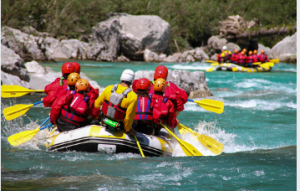Tips for Buying a Gravel Bike
If you are in the market for a gravel bike, you should know that there are some things you should consider before you make your purchase. From gearing ratios to the material of the frame, there are many factors to consider when you are in the market for a new bike.
Wider tires provide stability on the trail
When it comes to tyres on Pushbikes gravel bikes NZ, you want to choose the right size. Gravel bikes are built for off-road riding, and wider tires help provide stability on the trail.
 Many gravel bikes also have a longer wheelbase than road bikes. It gives them greater stability at speed and a larger turning radius. In turn, this allows them to handle a variety of terrain better.
Many gravel bikes also have a longer wheelbase than road bikes. It gives them greater stability at speed and a larger turning radius. In turn, this allows them to handle a variety of terrain better.
Compared to mountain bikes, gravel bikes have a more relaxed geometry, which makes them easier to ride. They also feature more tyre clearance, allowing room for wide tyres and extra tread. These can provide additional traction on sand, dirt, and other abrasive surfaces.
Typically, gravel bikes have a shorter top tube and longer head tube angle, which puts the rider in an upright, more comfortable position. The slack head tube angle helps keep the bike from feeling twitchy, but it does not help as much when the bike is going fast.
A gravel bike can also have disc brakes instead of rim brakes. Disc brakes provide consistent stopping power in all conditions and better modulation.
A gravel bike is great for commuting or leisure riding on light trails. Its lighter weight and wider tyres give it an edge over a standard road bike.
Choosing the right tyres for your gravel bike can improve your comfort, balance, and riding performance. You can run a wide range of tyres, from 36 to 45 mm wide, at various pressures.
You may also want to consider whether you should purchase a tubeless tyre. Tubeless tyres reduce the risk of pinch flats and allow you to keep the tyre pressure low.
Gearing ratios determine how it feels to pedal
There is a wide range of gravel bikes on the market today. Some feature full suspension, while others are single-chainring mountain bikes. They’re suitable for riding off-road, for utility, and even for recreation. But the gearing of these bikes can vary widely. It can make choosing one confusing.
The first step is to figure out what you want your bike to do. Whether you’re a serious commuter, a recreational rider, or a multi-day off-road enthusiast, you’ll want to choose a bike that fits your needs. It would be best if you also kept in mind that your choice of gravel drivetrain will be a personal choice. For example, you may prefer a higher gear ratio for climbing or a lower gear for descending.
Gearing ratios are a key factor in how it feels to pedal gravel bikes. In general, a lower gear ratio gives easier pedalling. However, you’ll need to ensure that the gearing is appropriate for the terrain and riding conditions you expect to encounter.
On the other hand, a higher gear can increase your cruising speed and help you maintain balance. However, you’ll likely need to spend more time in the lowest gears on climbs.
One option for a gravel bike is to choose a double chainset. It allows you to change between a smaller ring for steep climbing and a larger one for fast descents. Another option is to choose a wide-range cassette, which can deliver the same range as a single-chainring system.
Gravel-specific GRX groupsets are available from Shimano. These include 48/31t double chainsets and 46/30t double chainsets.
Another option is the SRAM XPLR groupset, which includes a 10-44t cassette. The company also offers 12-speed wireless gearing options.
An aluminium frame with carbon forks and a seat tube is a good compromise. There are many different choices available when it comes to gravel bikes. The key is to find the bike that best suits your needs. You want to ensure it’s not too heavy or too stiff.
Gravel bikes differ from road bikes in several important ways. First, they have a more upright stance. Second, they usually have a shorter top tube, and lastly, they are less aggressive.
An aluminium frame and carbon fork combination is a good compromise if you’re looking for a gravel bike. Aluminium is light and affordable and can handle some impacts. However, it’s not as durable as a carbon frame.
It can also be difficult to repair. If you do break your frame, it’s expensive to replace.
On the other hand, a good aluminium frame can last for many years. A good aluminium frame is also cheaper to produce.
Carbon forks are available in a wide variety of features. For example, some feature eyelets for mounting cargo cages. These can balance the rider’s weight and increase the gravel bike’s versatility.
Although an aluminium frame and carbon fork combination can be the right choice for a low-weight rider, there’s still a lot to consider. Choosing the right frame for your riding style is a great way to improve your comfort and happiness on your next gravel ride.
Carbon fibre is a good material for gravel bikes because it’s lightweight and strong. It is one of the reasons that some manufacturers pair carbon forks with high-quality steel frames.
Although titanium is expensive and difficult to manufacture, it is strong and corrosion-resistant. Titanium is also dent-resistant, so it’s likely to last for your lifetime.
You can opt for the skeleton system if looking for the lightest pedals. Unlike the flat or trail pedals, a skeleton pedal doesn’t have a platform that extends around the cleat mechanism. But they are cheap, and you can clean them easily.
If you’re looking for more support, you can opt for a trail pedal. These have replaceable bearings, and they are more robust. Also, they have a small support area beneath the shoe.






 Before buying a rafting tool, you should decide on its purpose. There are different types and sizes of rafts, just as there are different types of cars. For example, there are vehicles for skiing, racing, snowmobiling, and rafting trucks. Consider where you’re going and the type of water you’ll be paddling in. For instance, a technical stream will require a different kind of raft than a flowing, high-volume stream.
Before buying a rafting tool, you should decide on its purpose. There are different types and sizes of rafts, just as there are different types of cars. For example, there are vehicles for skiing, racing, snowmobiling, and rafting trucks. Consider where you’re going and the type of water you’ll be paddling in. For instance, a technical stream will require a different kind of raft than a flowing, high-volume stream.